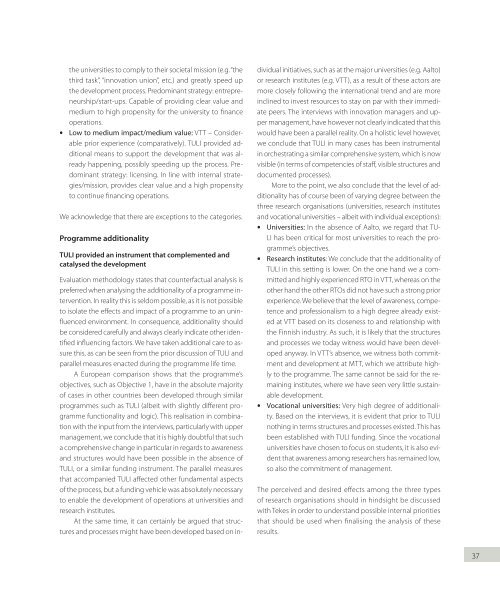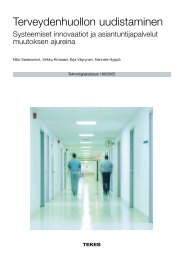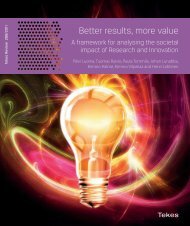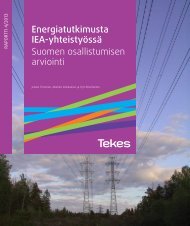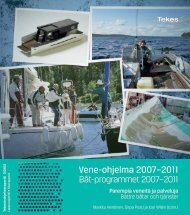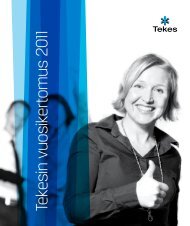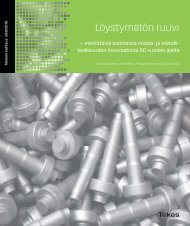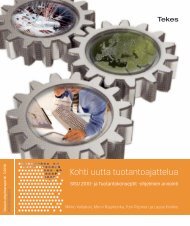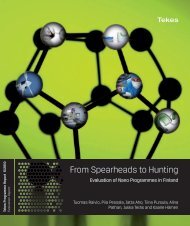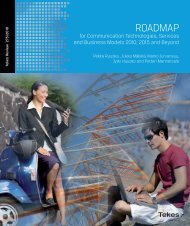Evaluation of TULI Programmes - Tekes
Evaluation of TULI Programmes - Tekes
Evaluation of TULI Programmes - Tekes
Create successful ePaper yourself
Turn your PDF publications into a flip-book with our unique Google optimized e-Paper software.
the universities to comply to their societal mission (e.g.“the<br />
third task”, “innovation union”, etc.) and greatly speed up<br />
the development process. Predominant strategy: entrepreneurship/start-ups.<br />
Capable <strong>of</strong> providing clear value and<br />
medium to high propensity for the university to finance<br />
operations.<br />
••<br />
Low to medium impact/medium value: VTT – Considerable<br />
prior experience (comparatively). <strong>TULI</strong> provided additional<br />
means to support the development that was already<br />
happening, possibly speeding up the process. Predominant<br />
strategy: licensing. In line with internal strategies/mission,<br />
provides clear value and a high propensity<br />
to continue financing operations.<br />
We acknowledge that there are exceptions to the categories.<br />
Programme additionality<br />
<strong>TULI</strong> provided an instrument that complemented and<br />
catalysed the development<br />
<strong>Evaluation</strong> methodology states that counterfactual analysis is<br />
preferred when analysing the additionality <strong>of</strong> a programme intervention.<br />
In reality this is seldom possible, as it is not possible<br />
to isolate the effects and impact <strong>of</strong> a programme to an uninfluenced<br />
environment. In consequence, additionality should<br />
be considered carefully and always clearly indicate other identified<br />
influencing factors. We have taken additional care to assure<br />
this, as can be seen from the prior discussion <strong>of</strong> <strong>TULI</strong> and<br />
parallel measures enacted during the programme life time.<br />
A European comparison shows that the programme’s<br />
objectives, such as Objective 1, have in the absolute majority<br />
<strong>of</strong> cases in other countries been developed through similar<br />
programmes such as <strong>TULI</strong> (albeit with slightly different programme<br />
functionality and logic). This realisation in combination<br />
with the input from the interviews, particularly with upper<br />
management, we conclude that it is highly doubtful that such<br />
a comprehensive change in particular in regards to awareness<br />
and structures would have been possible in the absence <strong>of</strong><br />
<strong>TULI</strong>, or a similar funding instrument. The parallel measures<br />
that accompanied <strong>TULI</strong> affected other fundamental aspects<br />
<strong>of</strong> the process, but a funding vehicle was absolutely necessary<br />
to enable the development <strong>of</strong> operations at universities and<br />
research institutes.<br />
At the same time, it can certainly be argued that structures<br />
and processes might have been developed based on individual<br />
initiatives, such as at the major universities (e.g. Aalto)<br />
or research institutes (e.g. VTT), as a result <strong>of</strong> these actors are<br />
more closely following the international trend and are more<br />
inclined to invest resources to stay on par with their immediate<br />
peers. The interviews with innovation managers and upper<br />
management, have however not clearly indicated that this<br />
would have been a parallel reality. On a holistic level however,<br />
we conclude that <strong>TULI</strong> in many cases has been instrumental<br />
in orchestrating a similar comprehensive system, which is now<br />
visible (in terms <strong>of</strong> competencies <strong>of</strong> staff, visible structures and<br />
documented processes).<br />
More to the point, we also conclude that the level <strong>of</strong> additionality<br />
has <strong>of</strong> course been <strong>of</strong> varying degree between the<br />
three research organisations (universities, research institutes<br />
and vocational universities – albeit with individual exceptions):<br />
••<br />
Universities: In the absence <strong>of</strong> Aalto, we regard that TU-<br />
LI has been critical for most universities to reach the programme’s<br />
objectives.<br />
••<br />
Research institutes: We conclude that the additionality <strong>of</strong><br />
<strong>TULI</strong> in this setting is lower. On the one hand we a committed<br />
and highly experienced RTO in VTT, whereas on the<br />
other hand the other RTOs did not have such a strong prior<br />
experience. We believe that the level <strong>of</strong> awareness, competence<br />
and pr<strong>of</strong>essionalism to a high degree already existed<br />
at VTT based on its closeness to and relationship with<br />
the Finnish industry. As such, it is likely that the structures<br />
and processes we today witness would have been developed<br />
anyway. In VTT’s absence, we witness both commitment<br />
and development at MTT, which we attribute highly<br />
to the programme. The same cannot be said for the remaining<br />
institutes, where we have seen very little sustainable<br />
development.<br />
••<br />
Vocational universities: Very high degree <strong>of</strong> additionality.<br />
Based on the interviews, it is evident that prior to <strong>TULI</strong><br />
nothing in terms structures and processes existed. This has<br />
been established with <strong>TULI</strong> funding. Since the vocational<br />
universities have chosen to focus on students, it is also evident<br />
that awareness among researchers has remained low,<br />
so also the commitment <strong>of</strong> management.<br />
The perceived and desired effects among the three types<br />
<strong>of</strong> research organisations should in hindsight be discussed<br />
with <strong>Tekes</strong> in order to understand possible internal priorities<br />
that should be used when finalising the analysis <strong>of</strong> these<br />
results.<br />
37


